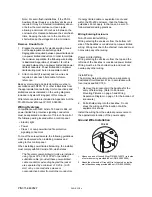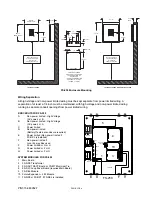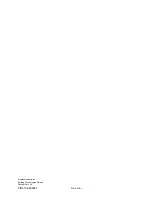
P/N 315-648952-7
PAGE 2 OF 4
Note: For semi-flush installations, if the PAD-3
Auxiliary Power Supply or a battery enclosure is
required, it may be mounted immediately above
or below the main enclosure, close nipple,
allowing a minimum of 3 inches in between the
enclosures for clearance between the semi-flush
trims. Keeping the wire run to the control unit
short will keep the voltage drop to a minimum.
Remove Knock-Outs
1.
Prepare the enclosure for electrical wiring, break
out the appropriate conduit entry points.
Segregation is required between power limited and
non-power limited conductors. In order to maintain
the minimum separation, the following wire routing
is illustrated. Separation of at least a 1/4 inch is
required between the non-power limited and power
limited conductors. Power limited and non-power
limited wiring must be run in separate conduit.
2.
Attach conduit (if required) and run wires as
required. Label each field cable for future
reference.
Basic system wiring and detector siting must be in
accordance with NFPA 72 or other instructions from
the appropriate local authority. Unit connections and
limitations are as indicated on the wiring diagrams
included in System Wiring part of this manual.
Wire reference data are included in Appendix A of the
FS-250 Owner’s Manual, P/N 315-048353.
Wiring Overview
In compliance with NEC Article 760 and UL 864, all
power limited fire protective signaling conductors
must be separated a minimum of 1/4 inch from all of
the following wiring located within a control panel:
• Electric light
• Power
• Class 1 or non-power limited fire protective
signaling conductors
To meet these requirements, the following guidelines
must be observed when installing modules and
wiring to this control panel.
When installing power limited field wiring, the installer
must comply with NEC article 760, which states:
The fire alarm power-limited circuits are installed
using Types FPL, FPLR, FPLP or permitted
substitute cable, provided these power-limited
cable conductors extending beyond the jacket
are separated by a minimum of 0.25 in. (6.35
mm) or by a nonconductive sleeve or
nonconductive barrier from all other conductors.
If energy limited cable or equivalent is not used
within the FS-250 enclosure, then the following
guidelines do not apply. In that case, be sure to
follow standard wiring
practices.
Wiring Entering Enclosure
Non-Power Limited Wiring
Wiring entering the enclosure from the bottom left
side of the backbox is considered non-power limited
wiring. Wiring must be in the shortest route and must
not overlap any other wiring.
Power Limited Wiring
Wiring entering the enclosure from the top and the
left side of the backbox is considered power limited.
Wiring must be in the shortest route and must not
overlap any other wiring.
Install Wiring
The primary mains input must have a separate or
dedicated circuit breaker. Wire in accordance with
local codes and NEC 760.
1.
Remove the knockouts in the backbox for the
entry of field wiring. (Refer to Enclosure
Mounting Pictures on page 3 and Wiring
Separation Diagram on page 3 for the location of
knockouts.)
2.
Pull all field wiring into the backbox. Do not
dress the wiring until the location of all the
equipment is known.
Install the wiring from the external power source to
the approximate location of the power supply.
Ground Wire Installation
FS-250
1. Attach one end of Ground Wire (P/N 600-149373) to inside
of outer door using provided #6 nut (P/N 950-220604).
2. Attach the other end of Ground Wire to top stud on inside
wall of backbox using provided #6 nut (P/N 950-220604).






















